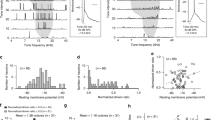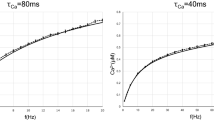Abstract
SPIKE frequency adaptation (SFA)—a decrease in firing frequency during the action of a maintained stimulus—is a mechanism for the input–output transformation of a signal and it is common at many levels of the animal kingdom. The occurrence of SFA in amphibian sensory nerves1–4 offers an opportunity to explain the phenomenon at the membrane level in terms of the Hodgkin–Huxley (HH) theory5. Here we show that SFA in amphibian nerve is probably due to a current through slow K channels, and we suggest that these channels must also be responsible for different cases of SFA in nerve cells of various types.
This is a preview of subscription content, access via your institution
Access options
Subscribe to this journal
Receive 51 print issues and online access
$199.00 per year
only $3.90 per issue
Buy this article
- Purchase on Springer Link
- Instant access to full article PDF
Prices may be subject to local taxes which are calculated during checkout
Similar content being viewed by others
References
Dodge, F. A., thesis, Rockefeller Inst. (1963).
Vallbo, A. B. Acta physiol. scand. 61, 413–428 (1964).
Honerjäger, P. Pflügers Arch. ges. Physiol. 303, 55–70 (1968).
Bergman, C., thesis, Univ. Paris (1969).
Hodgkin, A. L. & Huxley, A. F. J. Physiol., Lond. 117, 500–544 (1952).
Frankenhaeuser, B. & Huxley, A. F. J. Physiol., Lond. 171, 302–315 (1964).
Frankenhaeuser, B. & Vallbo, A. B. Acta physiol. scand. 63, 1–20 (1965).
Peganov, E. M., Khodorov, B. I. & Shishkova, L. D. Bull. exp. Biol. Med. 9, 15–19 (1973).
Schwarz, J. R. & Vogel, W. Pflügers Arch. ges Physiol. 330, 61–73 (1971).
Bergman, C. Pflügers Arch. ges. Physiol. 317, 287–302 (1970).
Dubois, J. M. & Bergman, C. Pflügers Arch. ges. Physiol. 358, 111–124 (1975).
Adelman, W. J. & FitzHugh, R. Fedn Proc. 34, 1322–1329 (1975).
Makovsky, V. S. Tsitologiya 17, 55–63 (1975).
Palti, Y., Ganot, G. & Stämpfli, R. Biophys. J. 16, 261–273 (1976).
Ilyin, V. I., Katina, I. E., Lonskii, A. V., Makovsky, V. S. & Polishchuk, E. V. Dokl. Akad. Nauk SSSR 234, 1467–1470 (1977).
Ilyin, V. I., Katina, I. E., Lonskii, A. V., Makovsky, V. S. & Polishchuk, E. V. J. Membrane Biol. (in the press).
Hille, B. thesis, Rockefeller Univ. (1967).
Bretag, A. H. & Stämpfli, R. Pflügers Arch. ges. Physiol. 354, 257–271 (1975).
Krylov, B. V. Dokl. Akad. Nauk SSSR 239, 1472–1475 (1978).
Cole, K. S. & Moore, J. W. Biophys. J. 1, 1–14 (1960).
Begenisich, T. & Stevens, C. F. Biophys. J. 15, 843–846 (1975).
Partridge, L. D. & Stevens, C. F. J. Physiol., Lond. 256, 315–332 (1976).
Khodorov, B. I. General Physiology of Excitable Membranes (Nauka, Moscow, 1975).
Sokolove, P. G. & Cooke, I. M. J. gen. Physiol. 57, 125–163 (1971).
Author information
Authors and Affiliations
Rights and permissions
About this article
Cite this article
KRYLOV, B., MAKOVSKY, V. Spike frequency adaptation in amphibian sensory fibres is probably due to slow K channels. Nature 275, 549–551 (1978). https://doi.org/10.1038/275549a0
Received:
Accepted:
Issue Date:
DOI: https://doi.org/10.1038/275549a0
This article is cited by
-
Neural Masking by Sub-threshold Electric Stimuli: Animal and Computer Model Results
Journal of the Association for Research in Otolaryngology (2011)
-
Effects of a slow potassium permeability on repetitive activity of the frog node of ranvier
Biological Cybernetics (1990)
-
Possible role of voltage-sensitive potassium channels in generation of response in Pacinian corpuscles
Neurophysiology (1988)
-
Model of adaptation of the nerve fiber ranvier node membrane to the action of a steady current as the result of sodium channel inactivation
Neurophysiology (1984)
-
Repetitive activity of a molluscan neurone driven by maintained currents: A supercritical bifurcation
Biological Cybernetics (1981)
Comments
By submitting a comment you agree to abide by our Terms and Community Guidelines. If you find something abusive or that does not comply with our terms or guidelines please flag it as inappropriate.



